Beautiful ride today. 51.2 miles @ 18.4 mph. View from the top of a hill heading north on Ronald Reagan about 2 miles north of 29.
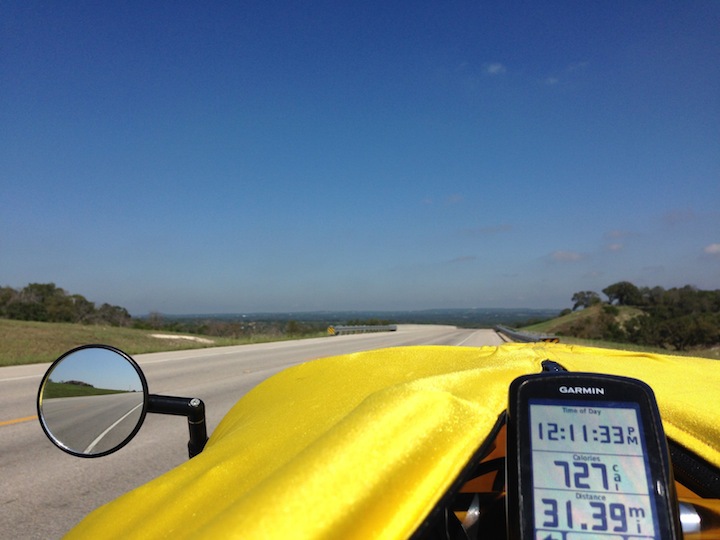
http://app.strava.com/activities/86246017
Beautiful ride today. 51.2 miles @ 18.4 mph. View from the top of a hill heading north on Ronald Reagan about 2 miles north of 29.

http://app.strava.com/activities/86246017
Just went for a relaxing spin today. Mounted the Contour+2 video camera on my helmet. Kind of an interesting perspective.
Heading south on Williams (FM 2338) approaching the corner of Ronald Reagan I happened to have the camera on when a 1950s Porsche 356 pulls up to the intersection and makes a right hand turn to pace me for a little while. We stare at each others yellow vehicle admiringly.
High speed coasting is a lot of fun with the F-40. Here I’m maintaining an easy 20 mph at a 100 bpm heart rate when I get to the downhill at Ronald Reagan and the back entrance to Sun City.
I stop peddling and just coast up to 36 mph.
A Prius starts to turn right pulling out in front of me. Once I take the lane they realize immediately how fast I am really going and quickly come to a stop.
http://connect.garmin.com/activity/383755277
Finally mounted the video camera to my helmet. Just a short, quick ride today to test it out.
Need to point it down just a tad.
Hopefully the weather will be good tomorrow for the Wac Wild West ride.
Easy ride today after two medium effort days of riding.
Saw the ICE Vortex trike again heading the other way. Since it was an easy ride I turned around and rode with the guy a little bit to gab. The rider is Brian P Buckmaster who lives in Sun City Georgetown TX. He just got the Vortex early September. Nice looking machine!
http://connect.garmin.com/activity/381598929
A FB friend of mine asked me today - ‘Is the F-40 meeting your expectations?’
Well, I had to think about it some.
I now have a total of 647 miles on the F-40 and another 236 miles with the fairing off as a P-38.
The total miles are a combination of training miles and four charity rides (two with each bike):
| Date | Bike | Miles | Charity Ride |
|---|---|---|---|
| Aug 4 | P-38 | 50 | Tour de Jalapeno |
| Aug 17 | F-40 | 60 | Copperas Cove Classic |
| Aug 24 | F-40 | 101 | Hotter 'N Hell Hundred |
| Sept 21 | P-38 | 66 | Conquer the Coast |
Of all the three 2-wheel recumbent’s I own (Optima Baron, Catrike Musashi and Lightning P-38) the P-38 is now my go to bike for easy, relaxed riding.
The one negative with the P-38 is you cannot have an aero-belly. Because of the closed riding position, any aero-belly will be bouncing off the tops of your legs as they rotate through the closest position while cycling. I have lost 10 pounds since getting the bike and now no longer seem to have this issue.
The Baron and Musashi are each probably slightly faster. The P-38 is more refined with a lot less quirks. I’ll probably end up selling the Baron and the Musashi.
I wasn’t really expecting to get a P-38 when purchasing the F-40. Regardless, the P-38 is an outstanding bike.
Although I have ~650 miles on the F-40 I still have not acclimated to the bike. Additionally, I still do not have the bike tuned correctly.
It probably took me about 1,000 miles to get the Musashi setup, tuned and myself acclimated. I was hoping that I could do it quicker on the F-40 because of my prior experience with both the Baron and Musashi. Alas, that turns out not to be the case - the F-40 is so much different that the other bikes that whole new skill sets and tuning are required.
Streamliner Expectations
Every hot, fit, young rider on a high-end time-trial bike sees the yellow fully faired streamliner as a target. You can, and will, go faster then them. The problem is that around the Austin TX area there are a lot of high end road bikes. You will be constantly challenged by uprights and riding pretty fast all of the time. This is definitely making me stronger. My average speeds and distances are improving. My legs ache all the time.Acclimating to 30+ mph
Life above 25 mph is interesting. Life above 30 mph is frightening. I have not yet learned how to relax at greater then 25 mph. Above 30 mph I end up having a death-grip on the handle bars. I know this is probably a mental thing, but I really need to figure it out. Maybe I need to do upper body workouts to improve my arm strength.The Wind
The wind turns out to be manageable. I don't yet have a complete reflex action to passing traffic.Riding Easy and Relaxed
I have yet to manage a long distance (50+ miles) easy paced relaxed ride. The F-40 rides always seem to turn into races. A couple of times I have started out to do an easy 50 mile ride where I ride 25 miles out, have lunch, then ride 25 miles back. These have always turned into racing efforts.The Magical Ride
With each bike there comes a ride where everything just clicks - and the ride is incredibly special. I've had a couple of training rides like this on the F-40.Early one Saturday morning is was pretty cool temps and no wind. I captured an incredible Strava KOM averaging 26.6 mph for 5.2 miles beating several professional triathletes. It was a magical ride.
I have not yet had a charity ride that was magical. The first charity ride (Copperas Cove) had very bad road conditions and ~3,500 feet of climbing. The second charity ride (Hotter ‘N Hell Hundred) had the last 1.5 hours in temps over 105 degrees.
Overall Impressions
IT IS VERY FAST. I ride the brakes a lot.The F-40 is a very demanding bike. In many ways it has exceeded my expectations. I have come to realize that my personal capabilities need to increase to meet the performance capabilities of the bike.
Another beautiful day for a ride. Hit three stoplights - 30 miles @ 20.5 mph.
Nice ride on the F-40 streamliner this morning. I’d forgotten how fast this bike really is.
30 miles @ 21.4 mph.
Had a hard time getting motivated to ride this morning. Finally decided to just go for an easy ride. Just a few minutes into it I realized again just how fast the F-40 really is.
Time to push is a little bit and have some fun.
Looks like I’ll have this Strava KOM for awhile.
http://connect.garmin.com/activity/380723174

Beautiful day for an easy recovery ride to the Blue Hole today.
http://connect.garmin.com/activity/380238674
Put the fairing back on the bike for tomorrows ride.
Removed the dual kickstand.

Late in the week the weather was expected to be heavy rain for the Saturday morning ride. But, come ride day the rain was mostly gone for the start of the ride. Robyn and I got the ride early. She was doing the 25 mile route on her new lime green Expedition Catrike. I opted for the 65 mile around the bay route. About 1,500 people lined up for the start and I spent some time before the start riding around the parking lot talking with other riders.
I met up with TWO other P-38 riders in the parking lot - both local to the Houston area and used their P-38s to commute daily.
The first 12 miles were a tough pound into a headwind of 20 mph gusting to 30 mph. As time went on the winds increased to 25 mph gusting to 35 mph. The decision late in the week to remove the fairing from the F-40 and ride the P-38 was the correct one.
The ride started out and almost immediately it was climb over the Harbor bridge directly into the 20 mph headwind. The start was organized into three waves for the 65 mile ride. The first wave was for riders expected to do 20+ mph, the second wave for riders expected to do 15-20 mph and then the rest of the riders in the last wave. I started at the front of the second wave (15-20 mph) and I could see that a lot of the riders in the first group did not really belong there (based upon my own prior health history I know that there are certain physiques that do not lend themselves to 20 mph average for 65 miles).
The Harbor bridge was an 8 percent grade for a half mile. I probably passed 30 percent of the first wave going up the bridge and then the next 12 miles were into the 20 mph headwind. The P-38 allowed me to better penetrate the headwind and again I passed many uprights in the first 12 miles. Of course it helped that the two other P-38s eventually caught me around mile marker 4 and we formed a rotating pace-line into the wind for about 8 miles. I really need to work on my pace-line abilities because I kept getting dropped off the back and had to work extra hard to re-acquire. It was really cool riding with two other P-38s. When passing uprights they would yell when the second P-38 passed them and then scream ‘THREE OF THEM’ when the third passed.
Finally after 28 miles we reached the Port Aransas ferry. They held the ferry for 15 minutes while it loaded up with bicycles and I think all the recumbents were on the same crossing as myself: three P-38s, a Carbon Aero 2.0 and an original small-wheeled Carbent. I wish I’d have taken pictures of the other recumbents.
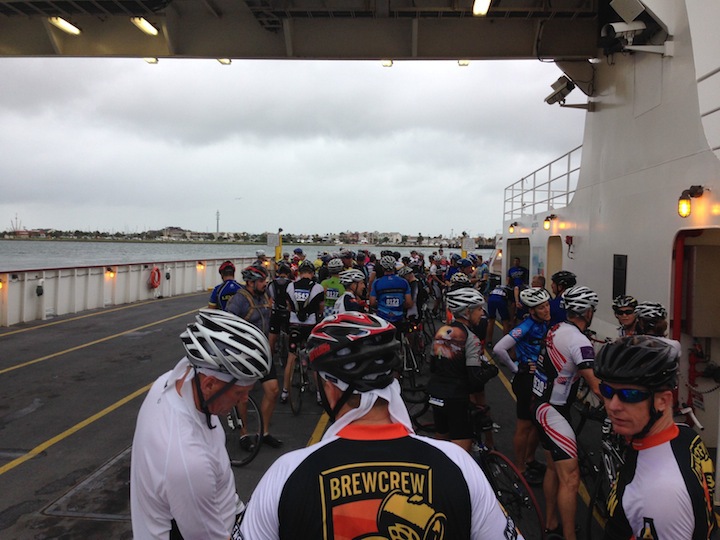
Once off the ferry, and headed south down Mustang Island, the wind became a quartering tailwind and the ride was a blast! For an hour, with the help of the tail wind, I averaged around 23 mph. Life was pretty darn good.
####The Good Life - Speeding down Mustang Island @ 23 mph####
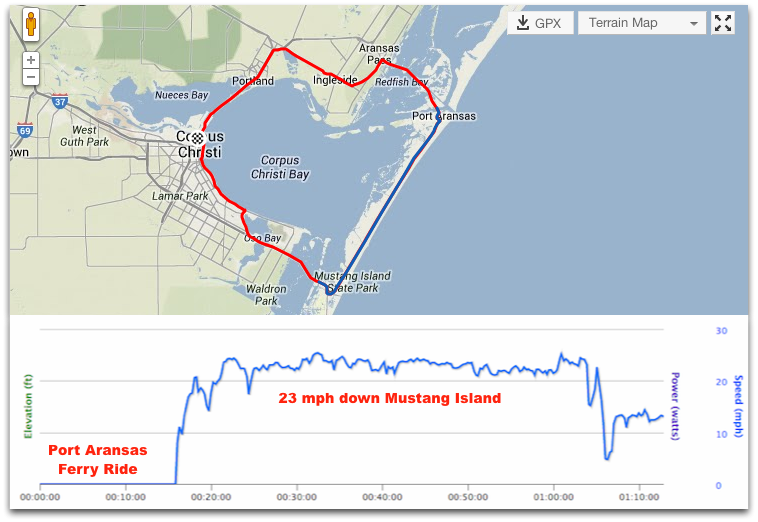
The good life ended at mile marker 48 where I came to the bridge at the southern end of Mustang Island. Again another 8 percent grade for 1/3 mile with a quarting headwind that had increased by now to 25 mph gusting to 35. The deep-v rim on the front of my bike was getting yanked all over the place and I had to maintain a death grip on the handle bars. At the top of the bridge it started raining - pelting and stinging like mad. I rode the brakes all the way down the other side of the bridge to keep under 10 mph just so that I could keep control of the bike. The rest of the ride over the 3 mile causeway was brutal. The hard rain, the 35 mph gusting wind picking up every little piece of sand and flinging it against me, the front wheel wanting to go every which way. I was pretty darn glad to make it back to land where there were some buildings to shield the wind every now and then.
Now it was another 14 miles into the headwind north back up the coast to Corpus Christi. The ride along Ocean Dr was beautiful (even if very windy).
Riding the last 12 miles along Ocean Dr with the headwind of 25 mph gusting to 35 mph I started to become concerned about Robyn because I knew that she also had to conquer this section of the ride on her Expedition Catrike. It was a real struggle for me on this section because I was already exhasted from the first 53 miles.
Three miles from the finish I get a flat front tire. Bummer. I was already so exhasted that it took me 20 minutes to change the tire. I’ve had two flats now in the last two weeks since I’ve changed the tires from Marathon Pluses to Kojaks. I think I’m going to try some Stan’s NoTubes sealant to see if I can stop the flats.
Riding through the finish gate I was very releaved to see Robyn having successfully completed the dificult 25 mile ride in the fierce wind.
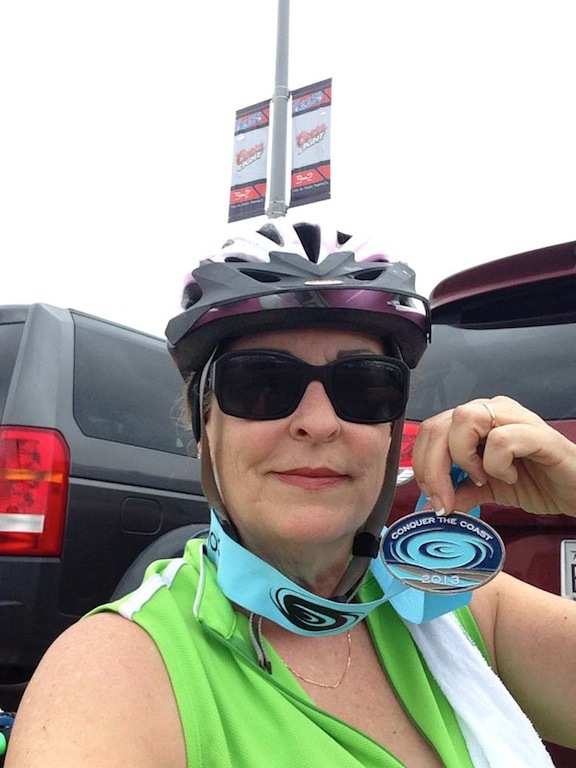
I noticed there is a difference between men and women in finish photographs. I have dirt and sand all over me. My bike jersey is all grease from changing the tire. I’m sitting in a chair because I can hardly move. Robyn on the other hand looks like she’s ready to go out for a night on the town. Hmmm, me thinks she may have primped before taking her photo?
Post ride celebration / recovery. That was one tough ride. I wanted an experience. I got it.
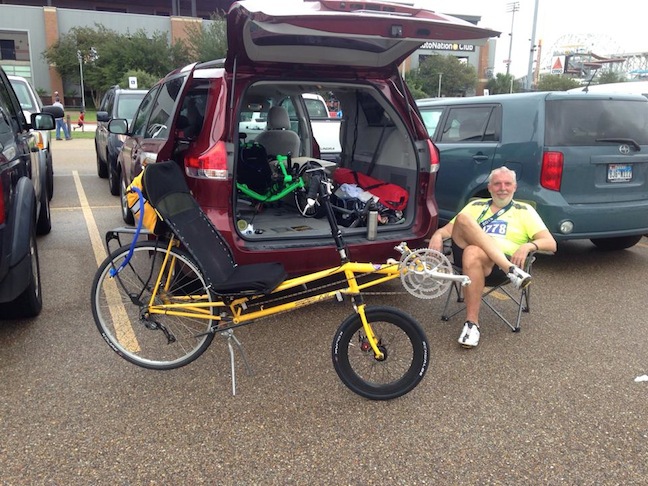
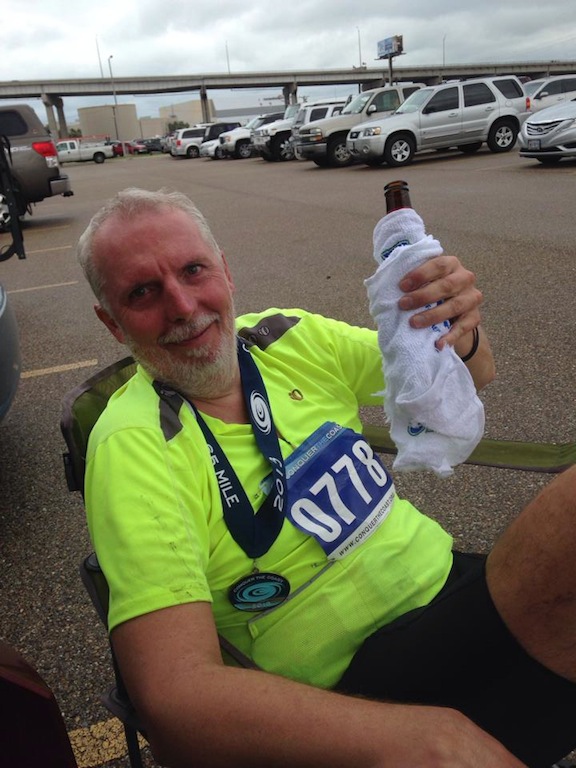
65.8 miles, four hours and ten minutes ride time. Only two breaks: 20 minutes on the ferry and 23 minutes changing the tire.
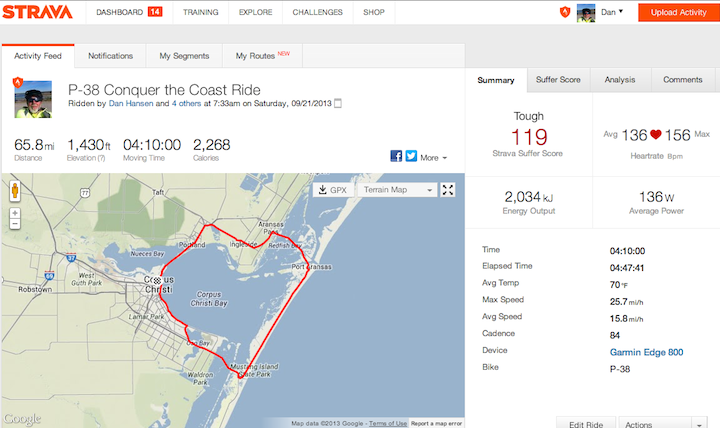
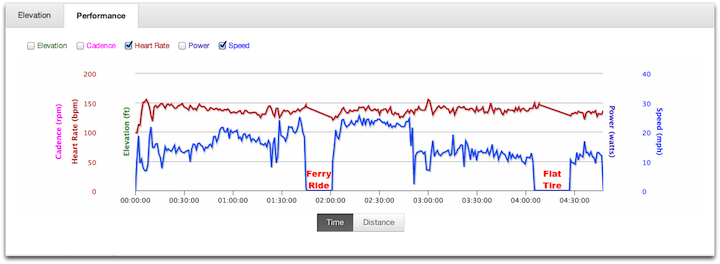
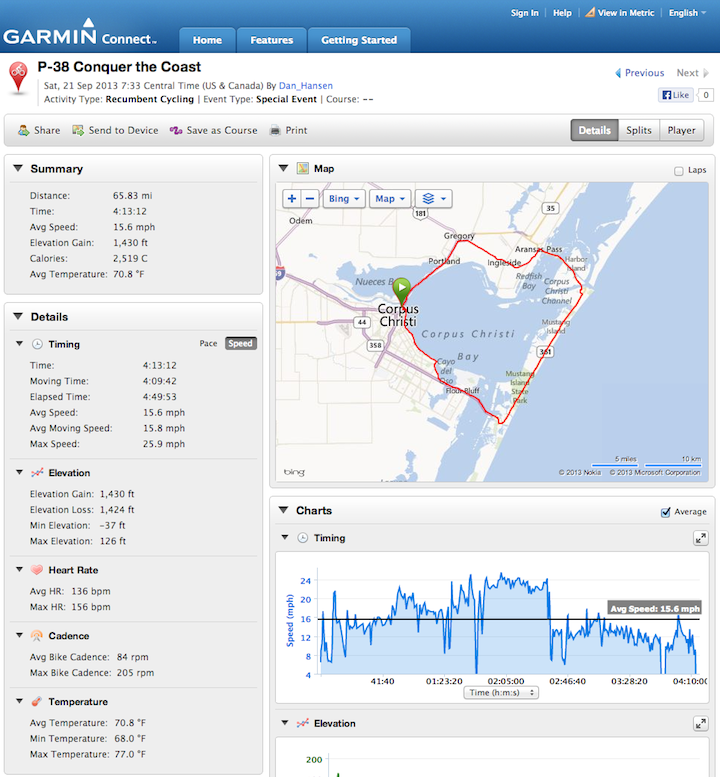
Of course by the next morning the weather had cleared - no wind, no clouds - just a beautiful morning sitting on the balcony having some coffee looking out over the bay.
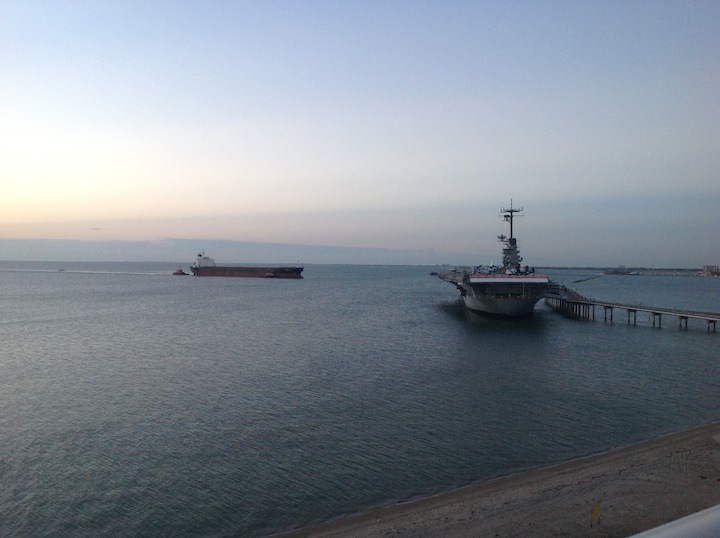
I’ve experimented with several ways to remove the fairing from the F-40 turning it into a P-38. These are my latest thoughts.
Taking the fairing off only requires about 10 minutes. Of course if you also take lots of pictures it can take a lot longer.
Start out with the spandex fully zipped up:
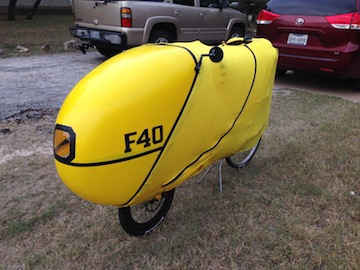
|

|
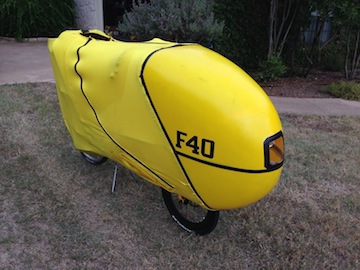
|
Next we are going to just peel the spandex off starting from the front and then proceed towards the back.
First un-velcro the two front sides:
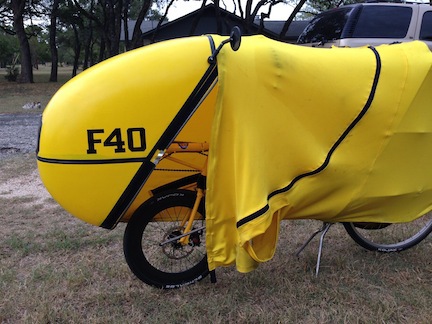
|
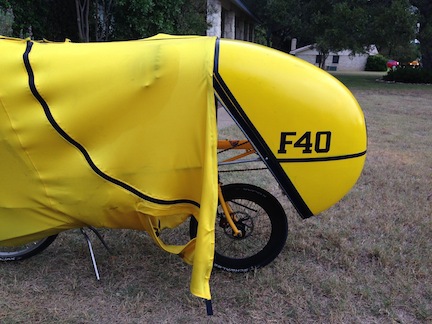
|
Unzip the bottom section:
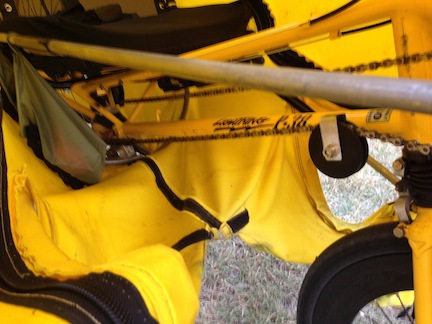
|
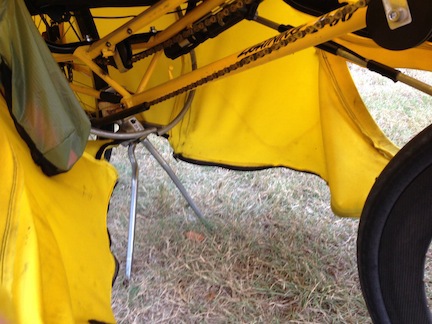
|
Now unvelcro and peel back the top spandex from the front fairing:
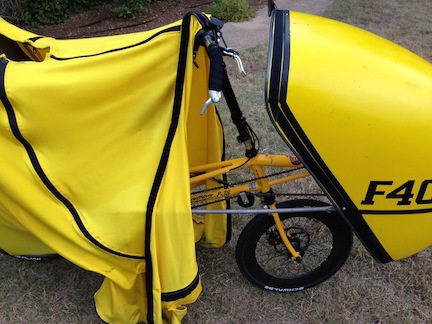
|
Keep gently peeling back the spandex until it is laying on the ground under the rear wheel.
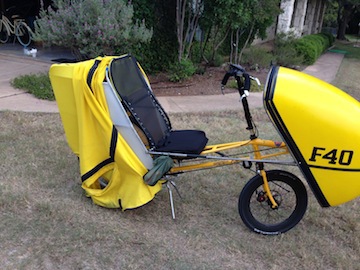
|
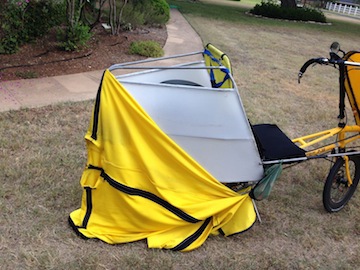
|
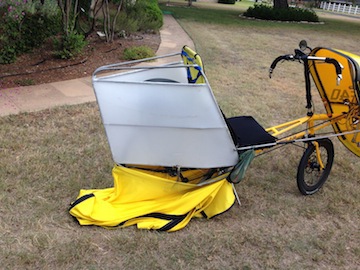
|
Unvelcro the spandex from the tail frame bottom:
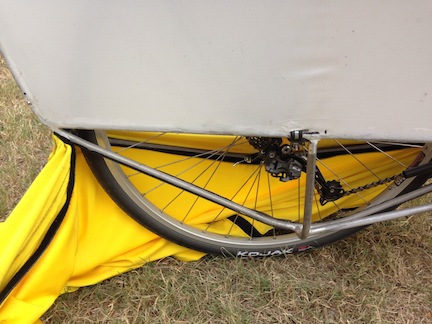
|
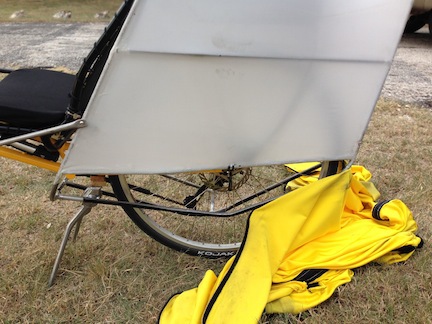
|
Put the spandex somewhere out of the way. Now the two things left to remove are the front fairing and the rear tail frame.
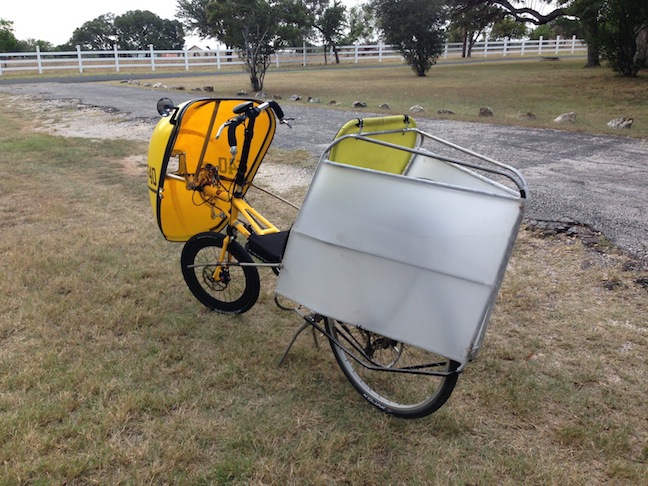
|
Tools you are going to need to take the fairing off:
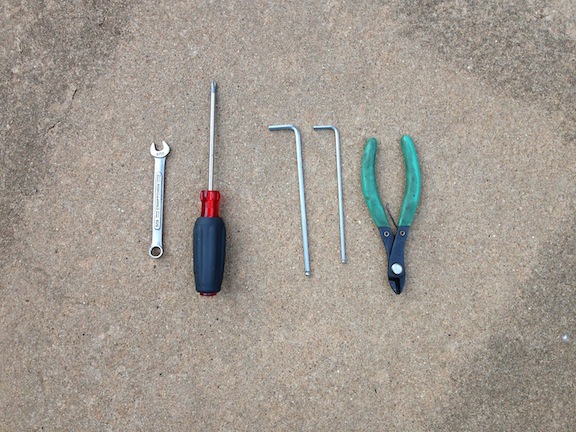
|
The front fairing is held on by two tie-wraps and the right side strut. The left side strut is spring-loaded attached so that you can enter and exit the F-40 easier.
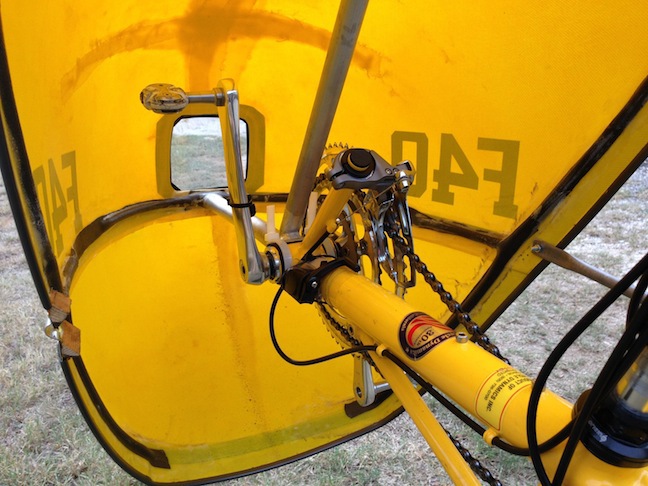
|
Disconnect the right side strut from the front fairing and snip the two tie-wraps at the bottom of the bottom-bracket.
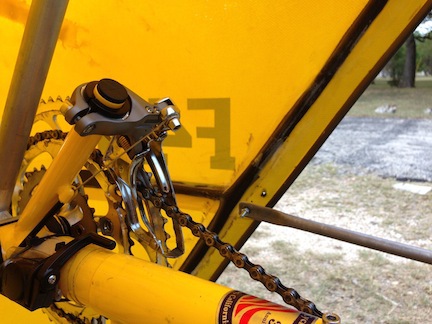
|
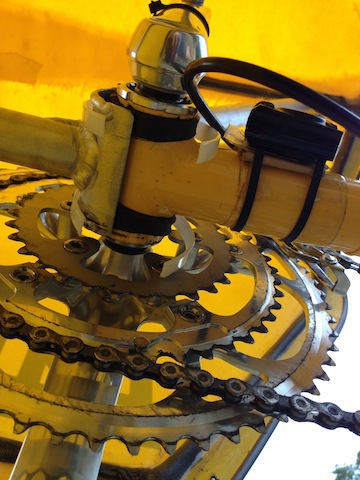
|
You are now ready to remove the front fairing. Never pull or push on the fairing itself. Only pull and push on the inside tubing structure. When removing the fairing I lay on the ground and brace my elbow against the front fork stem so that I wiggle/push the inside tubing with both hands. Gently wiggle off the front fairing.
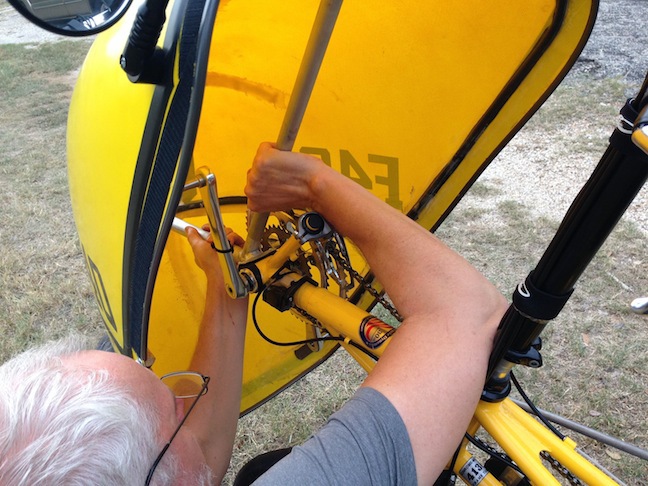
|
When I put the front fairing on I make sure to grease the rubber damper. When removing the fairing I make sure to remove the rubber damper from the front of the bike and store it inside the fairing.
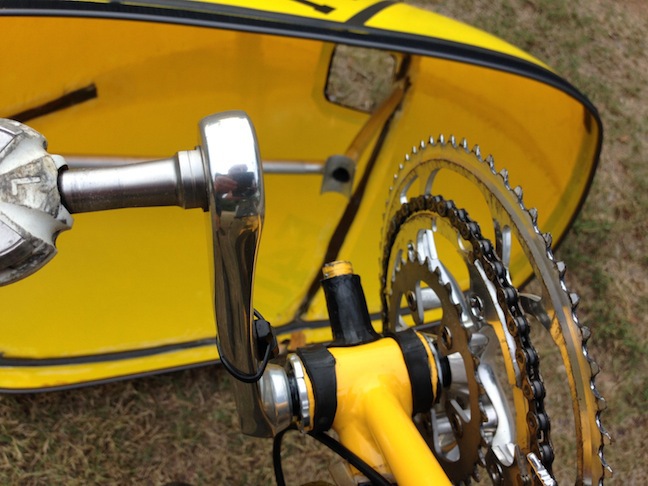
|
With the front fairing off the only thing left if the rear tail frame which is held on at 6 attachment points:
Remove the two side struts.

|
I keep the nuts and bolts attached to the struts so that I can find them again later when I want to put the fairing back on.
The right side strut has my feed bags attached. When riding I just reach down with my right hand and fish around in the bag for stuff. The other bag is for my cell phone so that I can easily reach it to take pictures.

|
Now remove the other 4 nut/bolts to take the rear tail frame off.
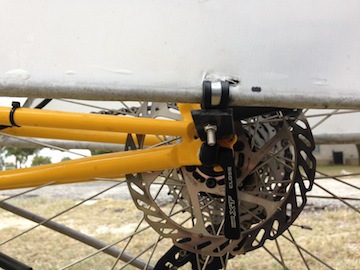
|
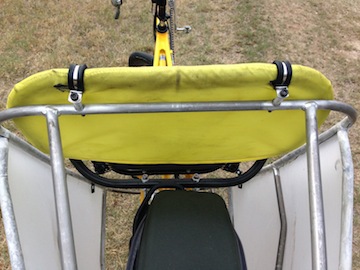
|
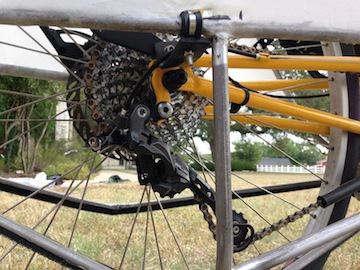
|
| 1 on the left dropout | 2 at the top of the seat | 1 on the right dropout |
I also remove the rack top bag because I use a seat back bag when riding the P-38
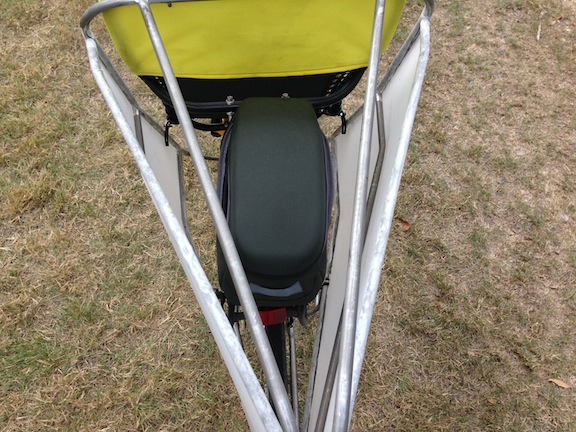
|
We now have a P-38
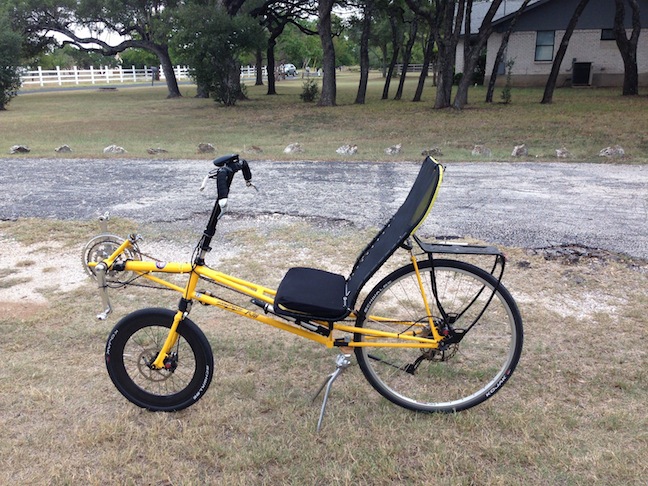
|
I move my stuff from the F-40 rack top bag to the P-38 seat back bag.
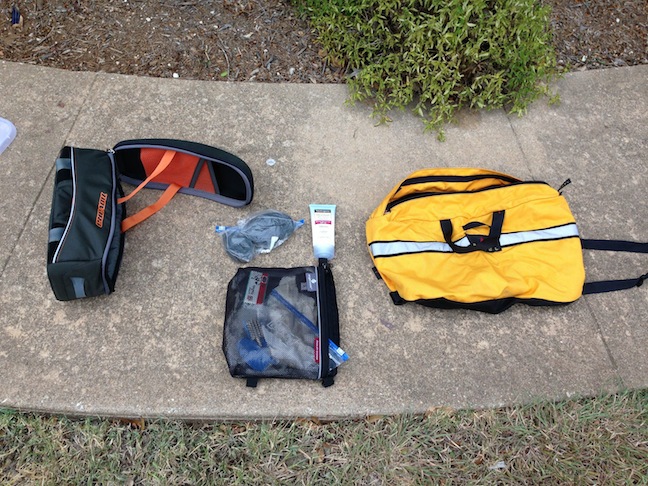
|
Put the seat bag on the back of the P-38
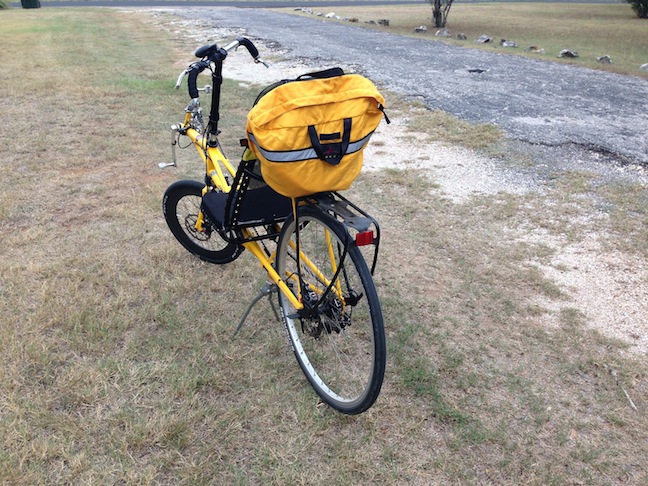
|
Of course when I went to go for a ride I remembered that I also needed to: